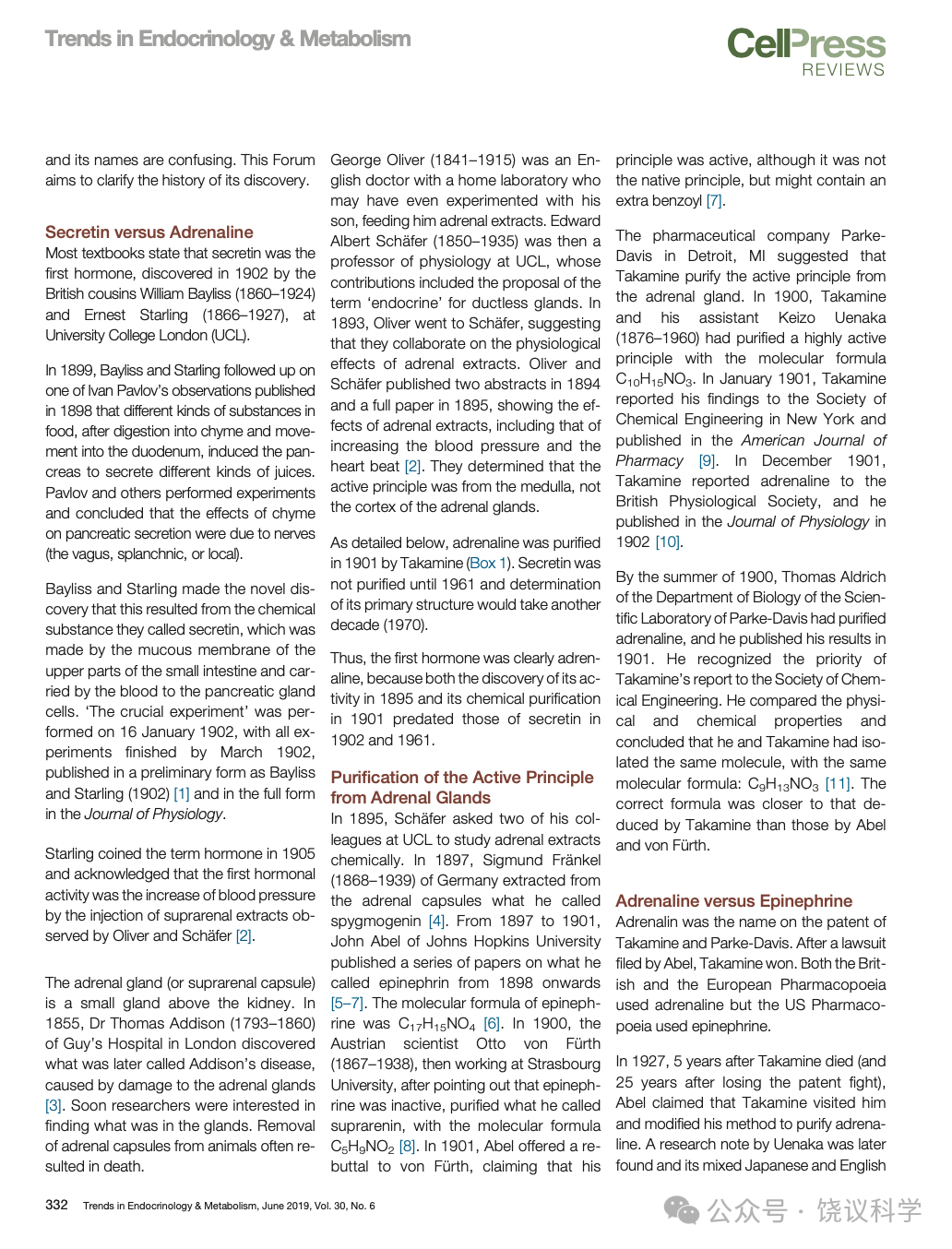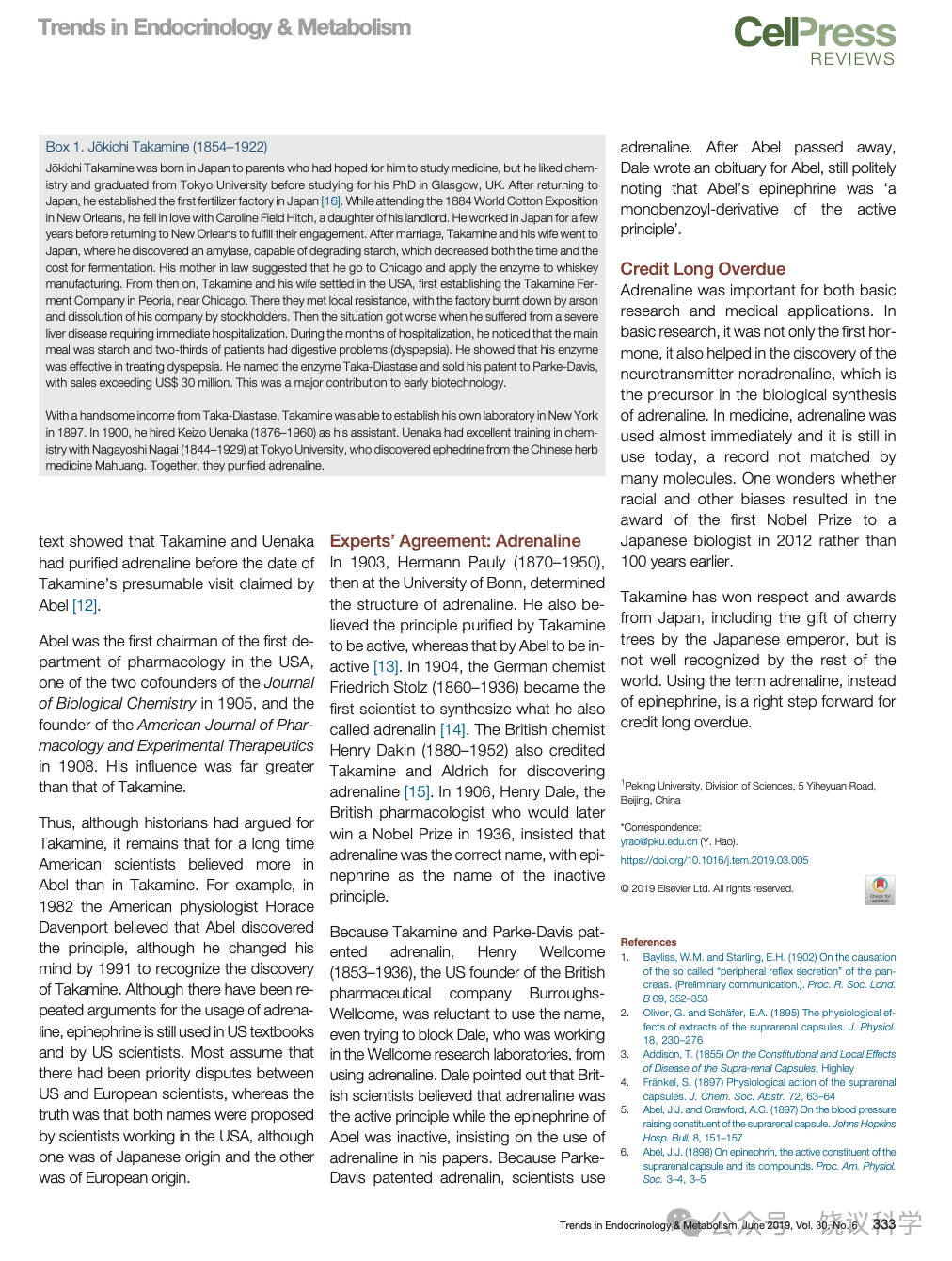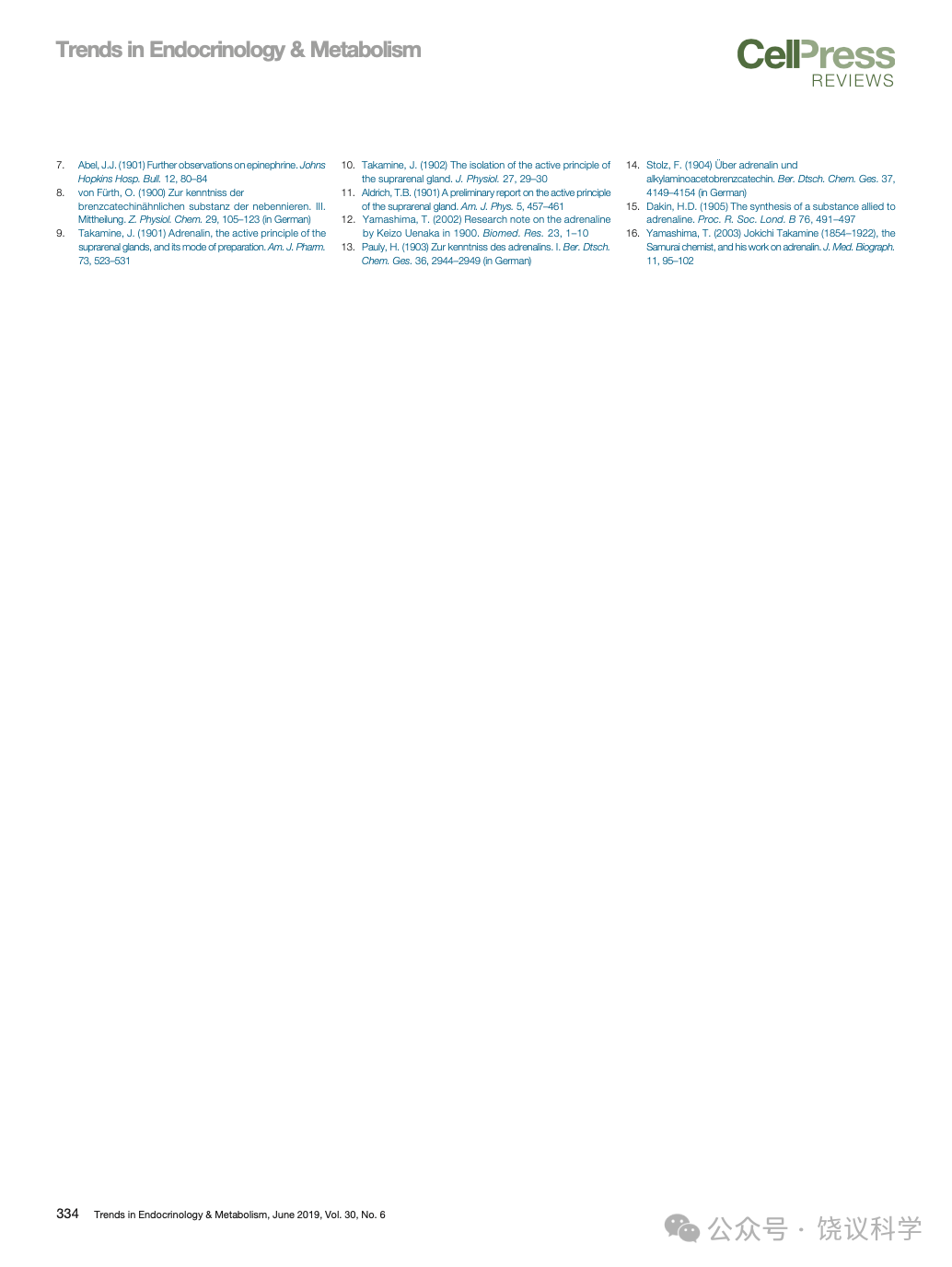中国科学史学界,迄今大部分工作集中研究中国的科学史。2019年,我在英文国际期刊《内分泌和代谢趋势》 发表文章,纠正世界科学史上一个传播时间和范围比较广的误解。
国际(特别是美国)内分泌学界、生理学界、药理学界,一般认为第一个激素是胰泌素,认为发现肾上腺素的是美国药理学家John Abel。
现在一般人误认为美国科学家和教科书称肾上腺素为epinephrine,英国和日本称肾上腺素为adrenaline是语言问题。
2019年我发表的文章澄清:第一个激素是肾上腺素,第一个发现正确肾上腺素的是日裔科学家高峰让吉 (Jōkichi Takamine,1854-1922),epinephrine和adrenaline不是语言问题,而是科学史问题,美国坚称的epinephrine早就被指出不是肾上腺素而是其失去活性的衍生物,adrenaline才是正确的命名。
不能排除这种可能性:这是罕见、甚至唯一在中国进行纠正世界科学史(而非中国科学史)重要问题。
这项工作并不难,依赖阅读和梳理35篇文章,其中英文《内分泌和代谢趋势》允许列出16篇,另外19篇在《知识分子》的中文介绍中补充列出。
冤屈百年
本文指出生物医学史上有三个错误与肾上腺素有关:一是误认为第一个激素是胰泌素,二是误认为化学分离纯化肾上腺素的为美国药理学家John Abel,三是美国坚称肾上腺素为epinephrine。
实际上:第一个激素是肾上腺素,因为发现活性的时间和分子得到纯化的时间都是肾上腺素先于胰泌素;分离到真正肾上腺素的是旅美日本科学家高峰让吉 (Jōkichi Takamine,1854-1922),时间为1901年;肾上腺素的英文正确名称为adrenaline,而epinephrine是无生物学活性的化学衍生物。
如果科学界真正公平,日本的第一项诺贝尔生理或医学奖可能就不是2012年,而推前一百年。日本本土和旅居西方的科学家在科学上有较多重大发现。不过,日本人还长期受美国无意忽视和有意打压。在生物学方面,早在1901年,日本科学家不止一次达到了相当高的程度。
高峰让吉
高峰让吉于1901年发现了世界上第一个激素:肾上腺素,命名为adrenalin。但教科书一般误认为1902年英国生理学家发现了第一个激素(胰泌素),而美国人坚持称肾上腺素为epinephrine,后两个错误遗留至今。
高峰让吉父母本希望他学医,但他喜欢上了化学,毕业于东京帝国大学应用化学系,后赴英国格拉斯哥念研究生。回日本后,他建了日本第一个化肥厂(日本人造肥料公司)(Yamashita,2003)。高峰让吉访问美国期间,与美国人Caroline Field Hitch恋爱,回日本工作后再度赴美完婚,其后妻子与他回日本。他在日本发现了一种淀粉酶(diastase,amylase),可以降解淀粉,大大降低发酵时间(和成本)。他的岳母建议他到芝加哥将这种酶用于威士忌制造过程。高峰让吉和妻子从此定居美国。他在芝加哥不远的Peoria建立了“高峰发酵公司”(Takamine Ferment Company),但遭反对,厂房被纵火焚毁,公司被解散。房漏偏逢下雨天,他自己又得了肝病,妻子以为他病得要死了,紧急住院,一住就几个月。住院期间,他意识到医院的饮食以淀粉为主,而三分之二的病人有消化不良(dyspepsia),他把自己发现的酶命名为Taka-Diastase(高峰淀粉酶),治疗消化不良很有效,他获得专利后将使用权授予Parke-Davis药厂,销售逾三千万美元,这是他对生物技术产业的贡献(Yamashita,2003)。
高峰让吉个人收入也可观,因此于1897年在纽约建自己的实验室。1900年,他请上中啟三(Keizo Uenaka,1876-1960) 为助手,后者的老师为东京帝大的长井长义(Nagayoshi Nagai,1844-1929),长井长义的一项重要科学工作是从中药麻黄提取麻黄素(ephedrine)(Nagai,1892)。
肾上腺髓质活性成分的分离纯化
位于美国密西根州底特律的Parke-Davis药厂建议高峰让吉分离提取肾上腺所含的化学分子。顾名思义,肾上腺是位于肾脏上面的一个腺体。1855年,伦敦Guy’s医院的Thomas Addison医生(1793-1860)发现肾上腺损害后的疾病,后称为Addison病,人们从而感兴趣肾上腺的内涵。很快就有科学家用动物做实验,试图看切除动物的肾上腺对动物的影响,常常发现动物死亡(Schäfer,1908)。
George Oliver(1841-1915)是一位对研究感兴趣的英国医生,在家做研究,设计实验仪器(如他自行了血压计,当时医生对血压还普遍不重视),甚至用儿子做实验动物。他曾给自己儿子吃肾上腺的提取物(Barcroft and Talbot, 1968)。伦敦大学学院生理系教授Edward Albert Schäfer(1850-1935)是著名生理学家,除了科学优秀,包括提出“内分泌”概念,还有个人特色,例如:为纪念自己的导师William Sharpey(1802-1880),Schäfer把长子命名为John Sharpey Schäfer。他儿子去世后,为了纪念老师和儿子,他把自己改名Edward Albert Sharpey-Schäfer,而且自己家的姓从此改成Sharpey-Schäfer。1893年,Oliver慕名找到 Schäfer,提出合作研究肾上腺提取物的作用(Davenport, 1991)。Oliver和 Schäfer于1894年发表两篇会议摘要、1895年发表文章,发现肾上腺提取物的作用,包括收缩血管、升高血压、加快心跳。
1895年,Schäfer让自己的两位同事研究了肾上腺提取物的化学特性(Moore,1895;Nabarro,1895)。1897年,德国科学家Sigmund Fränkel(1868-1939)提取了肾上腺的物质,他取名为spygmogenin(Fränkel,1897)。1897年,美国霍普金斯大学药理学系John J Abel(1857-1938)从肾上腺提取到一个分子(Abel and Crawford, 1897; Abel, 1898,1899),他命名为epinephrin,分子式为C17H15NO4(Abel, 1898)。1900年,在德国斯特拉斯堡大学工作的奥地利犹太科学家Otto von Fürth(1867-1938)认为epinephrin没有生物学活性,Fürth把自己从肾上腺提取的分子命名为suprarenin,分子式为C5H9NO2(von Fürth,1900)。1901年,Abel发表专文回复Fürth的质疑,辩解自己分离的分子还是有活性的,但它不是天然分子(native principle)而是衍生物,可能多了一个苯甲酰(benzoyl)(Abel,1901)。
1900年,高峰让吉和上中啟三获得了生物活性很强、结晶纯的分子,分子式为C10H15NO3。高峰的朋友Wilson医生建议他命名为adrenaline。高峰让吉于1901年1月在纽约举行的化工学会作报告,并于1901年在《美国药学杂志》发表其结果(Takamine,1901)。1901年12月高峰让吉在英国生理学会作报告,并于1902年发表于英国《生理学杂志》(Takamine,1902)。
Parke-Davis药厂科学实验室生物部的Thomas Aldrich于1900年夏也分离了肾上腺素,1901年发表了论文。他认同高峰让吉当年年初在化工学会的报告, Aldrich通过实验比较了自己的样本和高峰让吉的样本,推出两种样本的正确分子式都是:C9H13NO3(Aldrich,1901)。这一正确的分子式也最接近高峰此前推出的分子式,而与Abel和Fürth的分子式相差甚远。
同研究领域的科学家通常称Adrenaline而非Epinephrine
1903年,德国伯恩大学的化学家Hermann Pauly(1870-1950)确定了肾上腺素的结构式(Pauly,1903,1904),他也认为高峰让吉分离纯化了有活性的分子,而Abel的epinephrine不可能有活性。
1904年,第一位合成肾上腺素的德国化学家Friedrich Stolz(1860-1936)也用adrenalin名称(Stolz,1904)。1905年,英国科学家Henry Dakin(1880-1952)合成adrenaline时引用高峰让吉和Aldrich作为发现adrenaline,而不是引用Abel的文章作为发现(Dakin,1905)。
1906年,英国著名药理学家、1936年诺奖得主Henry Dale(1875-1968)坚持认为adrenaline是正确的命名,而不能以Abel没有活性的epinephrine命名(Tansey,1995;Aronson,2000)。1908年,曾于1895年发现肾上腺活性的Schäfer建议名称为adrenin(Schäfer,1908)。
争议
高峰让吉和Parke-Davis药厂申请的专利是Adrenalin,而且Abel提出诉讼后,高峰让吉在法庭胜诉。英国药典一直用adrenaline的名称,而美国药典用epinephrine是错误的,原因是Abel长期不认错。不仅如此,在高峰让吉去世5年后、高峰譲吉获得专利25年后,Abel在《科学》发表文章还说高峰让吉是来他实验室听他说如何分离肾上腺素的(Abel,1927)。日本人后来找到上中啟三的个人笔记,日文、英文夹杂,明确显示上中啟三认为Abel和Fürth的都不对,而且高峰让吉和上中啟三找到肾上腺素的时间早于Abel号称的高峰让吉访问Abel的时间(Yamashita,2002)。
Abel是美国药理学的开创性人物,是美国第一位专职的药理学教授、美国第一位药理学系主任,共同创办了《生物化学杂志》、创办了《美国药理与实验治疗学杂志》,他对美国学界的影响远大于高峰让吉,对Abel的各种介绍(包括Wiki)中,至今仍广泛流传有关epinephrine的按Abel版本的错误记载。高峰让吉不仅未获美国任何学术荣誉,而且无美国国籍。即使当时美国、德国和英国同行都认同高峰让吉(Aldrich,1901;Pauly,1903,1904;Stolz,1904;Dakin,1905),即使高峰让吉赢得专利(Yamashita,2002),即使美国科学家有文章确定高峰让吉的发明权(Bett,1953;Tansey, 1995; Aronson, 2000),即使德国科学界不用德国科学家取的suprarenin名称,但很长时间美国科学家还信Abel。例如直到1982年,美国生理学家Davenport仍认为是Abel发现了肾上腺素(Davenport,1982),到1991年才认为是高峰让吉发现了肾上腺素(Davenport,1991)。而直到今天,错误的名称epinephrine继续被美国科学界使用。大部分人不知道为什么有美国的名称和欧洲/日本的名称,以为是美国和欧洲/日本竞争。其实两个名称都源自美国工作的科学家。
这一争议还有药厂参与。因为Parke-Davis药厂将“Adrenalin”注册了专利,英国Wellcome药厂的美国创办人Henry Wellcome(1853-1936)不愿用这一命名,试图阻止在药厂研究部工作的Dale用adrenaline名称、而要求他用epinephrine。Dale指出英国科学界认为adrenaline是肾上腺有活性的物质,而Abel的epinephrine是没有活性的物质,坚持在自己论文中用adrenaline的名称(Tansey,1995)。因Parke-Davis专利的名称为Adrenalin,此后通用adrenaline(A小写,最后有e)。Abel去世后,Dale在皇家学会的纪念文章虽然赞扬Abel为主、但仍文雅地指出Abel发现的是活性分子的苯甲醛衍生物,如果有时间也可能分离到活性成分(Dale,1939)。
这一争议中,个人的争名夺利、学界的霸权行为和社会的种族歧视,孰轻孰重不容易说清楚,可能都逃不脱干系。
第一个激素
基本全世界教科书都认为第一个激素是secretin(肠促胰泌素),发现者为英国的一对表兄弟、生理学家William Bayliss(1860-1924)和Ernest Starling(1866-1927),时间是1902,地点是伦敦的大学学院。
Bayliss和Starling在研究小肠的运动(Bayliss and Starling,1899)。俄国生理学家巴甫洛夫于1898年发现不同食物经过胃处理为食糜而进入十二指肠或回肠后,刺激胰腺分泌,而且不同食物的食糜导致胰腺分泌的成分不同。巴甫洛夫和其后其他研究者在实验后提出这都是由于神经所介导的,可以是迷走神经、内脏神经、或肠道局部的神经。
Bayliss和Starling发现这不是由于神经,而是由小肠分泌一种化学物质(胰泌素),通过血液到胰腺刺激胰腺细胞分泌。他们于1902年1月16日进行“关键实验”,1902年3月完成所有实验,先在皇家学会会刊发表初步结果(Bayliss and Starling,1902a),再在英国《生理学杂志》发表全文(Bayliss and Starling,1902b)。
1905年,Starling提出激素的命名(Starling,1905a),但承认第一个激素活性为1895年Oliver and Schäfer注射肾上腺提取物观察到升高血压的作用(Starling,1905b)。1902年Bayliss和Starling达到的程度与1895年Oliverand Schäfer达到的程度相似,发现了胰泌素的活性,知道其不同于神经,但并未清楚其化学本质。而1901年高峰让吉已经知道肾上腺素的活性和化学本质。胰泌素要等将近60年才被纯化(Jorpes and Mutt, 1961),其一级结构还要近十年才被完全确定(Mutt, Jorpes and Magnusson, 1970)。所以无论从生物学活性还是化学本质来说,肾上腺素都是第一个激素。
早该还高峰让吉的功劳
肾上腺素在基础和应用两方面都有很重要的意义:基础方面,它不仅是第一个激素,它还对神经生物学很重要;应用方面,最简单的是立即提高血压,这是很多急救的一个措施,迄今还在被使用。
日本第一位生理或医学诺奖得主山中伸弥的工作是他在2006年发现4个因子可以将分化的细胞重编程成为干细胞。这一工作的重要性并不高于高峰让吉的工作:1)重编程是已知的,山中伸弥没有发现重编程,而是发现可以重编程的四个因子,高峰让吉也没有提出内分泌、或神经递质,只是发现第一个激素(以及与第一个神经递质相关);2)山中伸弥发现的因子,不是内源的重编程因子,高峰让吉发现的激素是内源激素;3)山中伸弥发现的因子,迄今只能用于研究,尚无实际应用,而且因为其中一个分子的可能致癌性而不能排除它们不能直接应用的可能性。相比而言,高峰让吉的发现不仅很快得到应用,而且迄今仍然应用。
日本一直非常重视高峰让吉,给他很多荣誉,但他在世界科学界恐怕是冤屈百年。迄今,没有任何迹象显示这一逾百年的冤案会得到澄清。澄清的标志之一应该是epinephrine一词从此不再为科学界所使用,而只用adrenaline一词。
不过,高峰让吉并非第一位在生物医学方面做出重要贡献的日本人。例如,1897年,志贺潔(Shiga Kiyoshi,1871-1957)发现痢疾的致病菌。该细菌被称为“志贺氏杆菌”(Shigella)。痢疾流行在很长年代是人类的大敌,志贺潔发现如此重要的致病菌,善莫大焉。百年后的今天,还没有一个如此重要致病菌是以中国人命名的。
(TEM杂志编辑限制本文参考文献只能16篇,发表版删除了另外19篇引用文章及其相应文字。本文要点为《生物学概念与途径》一书第十章的注释6)
The First Hormone: Adrenaline
Yi Rao
PKU-IDG/McGovern Institute for Brain Research; Peking-Tsinghua Center for Life Sciences; Chinese Institute for Brain Research, Beijing, Beijing, China
Abstract
It is not often that three mistakes are associated with one molecule for more than a century. This is the case with adrenaline. The record is set here that adrenaline is the first hormone with the discovery of its activity and chemical purification prior to secretin. Adrenaline is the correct name given by JōkichiTakamine, epinephrine being its inactive benzoyl derivative.
While adrenaline is a well-known molecule, there have long been three misconceptions. Adrenaline has not been recognized as the first hormone, its discover remains obscure, and it has two names. This article sets the history straight and clarifies these confusions.
Secretin vs Adrenaline
Most textbooks state that secretin is the first hormone, discovered in 1902 by the British cousins William Bayliss (1860-1924) and Ernest Starling (1866-1927), at the University College London (UCL).
In 1899, Bayliss and Starling followed up on one of Ivan Pavlov’s observations published in 1898 that different kinds of substances in the food, after digestion into chyme and movement into the duodenum, induced the pancreatic to secrete different kinds of juices. Pavlov and others have performed experiments and concluded that the effects of chyme on pancreatic secretion were due to nerves (either the vagus, splanchnic or local). Bayliss and Starling made the novel discovery that this resulted from the chemical substance they called secretin, which was made by the mucous membrane of the upper parts of the small intestine, carried by the blood to the pancreatic gland cells.“The crucial experiment” was performed on January 16th, 1902, with all experiments finished by March, 1902, published in a preliminary form as Bayliss and Starling (1902a) and in the full form as Bayliss and Starling (1902b). Starling coined the term hormone in 1905 (Starling, 1905a), and acknowledged (Starling, 1905b) that the first hormonal activity was the increase of blood pressure by the injection of supra-renal extracts observed by Oliver and Schäfer (Oliver and Schäfer, 1895).
The adrenal gland (or supra-renal capsule) is a small gland above the kidney. In 1855, Dr. Thomas Addison (1793-1860) of Guy’s Hospital in London discovered what was later called Addison’s disease, caused by damages to the adrenal glands. Soon researchers were interested in finding substances in the glands. Removal of adrenal capsules from animals often resulted in death (Schäfer, 1908).
George Oliver(1841-1915)was an English doctor with a home laboratory who might have experimented with his son, feeding adrenal extracts to his son (Barcroft and Talbot, 1968). Edward Albert Schäfer (1850-1935) was then a professor of physiology at UCL, whose contributions included the proposal of the term “endocrine” for ductless glands. In 1893, Oliver went to Schäfer, suggesting a collaboration on the physiological effects of adrenal extracts (Davenport, 1991). Oliver and Schäfer published two abstracts in 1894 and a full paper in 1895, showing the effects of adrenal extracts, including those of increasing the blood pressure and increasing the heart beat (Oliver and Schäfer, 1895). They determined that the active principle was from the medulla, not the cortex of the adrenal glands.
Secretin was not purified until almost six decades later (Jorpes and Mutt, 1961) and determination of its primary structure would take another decade (Mutt, Jorpes and Magnusson, 1970).
Thus, the first hormone was clearly adrenaline, because both the discovery of its activity in 1895 and its chemical purification in 1901 predated those of secretin in 1902 and 1961.
Purification of the Active Principle from the Adrenal Gland
In 1895, Schäfer asked two of his colleagues at UCL to study adrenal extracts chemically (Moore, 1895; Nabarro, 1895). In 1897, SigmundFränkel (1868-1939) of Germany extracted from the adrenal capsules what he called spygmogenin (Fränkel, 1897). From 1897 to 1901, John Abel of Johns Hopkins University published a series of papers on what he called epinephrin from 1898 onwards (Abel and Crawford, 1897; Abel 1898, 1899, 1901). The molecular formula of epinephrine was C17H15NO4 (Abel, 1898). In 1900, the Austrian scientist Otto von Fürth (1867-1938), then working at Strasbourg University, after pointing out that epinephrine was inactive, purified what he called suprarenin, with the molecular formula of C5H9NO2 (von Fürth, 1900). In 1901, Abel offered a rebuttal to Fürth, claiming that his principle was active, although it was not the native principle, but might contain an extra benzoyl (Abel, 1901).
The pharmaceutical company Parke-Davis in Detroit, Michigan asked Takamine to purify the active principle from the adrenal gland. In 1900, Takamine and his assistant Keizo Uenaka (1876-1960) succeeded in purifying the highly active principle, with the molecular formula of C10H15NO3. In January 1901, Takamine reported his findings to the Society of Chemical Engineering in New York and published in theAmerican Journal of Pharmacy (Takamine, 1901). In December 1901, Takamine reported adrenaline to the British Physiological Society and published the Journal of Physiology in 1902 (Takamine, 1902).
By the summer of 1900, Thomas Aldrich of the Department of Biology of the Scientific Laboratory of Parke-Davis had also purified adrenaline, which he published in 1901. He recognized the priority of Takamine’s report to the Society of Chemical Engineering. He compared the physical and chemical properties and concluded that he and Takamine had isolated the same molecule, with the same molecular formula: C9H13NO3(Aldrich, 1901). The correct formula was closer to that deduced by Takamine than those by Abel and Fürth.
Adrenaline vs Epinephrine
Adrenalin was the name in the patent of Takamine and Parke-Davis. After a lawsuit filed by Abel, Takamine won(Yamashima, 2003). Both the British and the European Pharmacopoeia used adrenaline but the US Pharmacopoeia used epinephrine.
Five years after Takamine died (and 25 years after losing the patent fight), Abel claimed that Takamine visited him and modified his method to purify adrenaline (Abel, 1927). A research note by Uenaka, was later found and its mixed Japanese and English text showed that Takamine and Uenaka had purified adrenaline before the date of Takamine’s presumable visit claimed by Abel (Yamashima, 2002).
Abel was the first chairman of the first department of pharmacology in the US, one of the two co-founders of theJournal of Biological Chemistry in 1905, and the founder of the American Journal of Pharmacology and Experimental Therapeutics in 1908. His influence was far greater than that of Takamine.
Thus, even though historians had argued for Takamine (Bett, 1953; Tansey, 1995; Aronson, 2000), it remains for a long time that American scientists believe more in Abel than in Takamine. For example, the American physiologist Horace Davenport in 1982 believed that Abel discovered the principle, although he changed his mind by 1991 to recognize the discovery of Takamine (Davenport, 1982, 1991). Even though there have been repeated arguments for the usage of adrenaline (e.g., Aronson, 2000), epinephrine is still used in American textbooks and by American scientists. Most assume that there had been priority disputes between American and European scientists, whereas the truth was that both names were proposed by scientists working in the US, though one of Japanese origin and the other of European origin.
Experts’ Agreement: Adrenaline
In 1903, Hermann Pauly (1870-1950), then at the University of Bonn, determined the structure of adrenaline. He also believed the principle purified by Takamine to be active, whereas that by Abel inactive (Pauly, 1903, 1904). In 1904, the German chemist Friedrich Stolz (1860-1936) became the first scientist to synthesize what he also called adrenalin (Stolz, 1904). The British chemist Henry Dakin (1880-1952) also credited Takamine and Aldrich for discovering adrenaline (Dakin, 1905). In 1906, Henry Dale, the British pharmacologist who would win a Nobel prize in 1936, insisted that adrenaline was the correct name, with epinephrine as the name of the inactive principle (Tansey, 1995; Aronson, 2000). In 1908, Schäfer suggested the name of adrenin (Schäfer, 1908), though it was never used by him or others later.
Because Takamine and Parke-Davis patented Adrenalin, Henry Wellcome (1853-1936), the American founder of the British pharmaceutical company Burroughs-Wellcome was reluctant to use the name, even trying to block Dale who was working in the research laboratories of Wellcome from using adrenaline. Dale pointed out that British scientists believed that adrenaline was the active principle while epinephrine of Abel was inactive, insisting the usage of adrenaline in his papers (Tansey, 1995). Because Parke-Davis patented Adrenalin, scientists use adrenaline. After Abel passed away, Dale wrote an obituary for Abel, still politely noting that Abel’s epinephrine was “a monobenzoyl-derivative of the active principle” (Dale, 1939).
Credit Long Overdue
Adrenaline is important for both basic research and medical applications. In basic research, it is not only the first hormone, it also helped the discovery of the neurotransmitter noradrenaline which is the precursor in the biological synthesis of adrenaline. In medicine, adrenaline was used almost immediately and is still in use today, a record not matched by many molecules. One wonders whether racial and other biases resulted in the award of the first Nobel prize to a Japanese biologist in 2012 rather than a hundred years earlier.
Takamine has won respects and awards from Japan, including the gift of cherry trees by the Japanese emperor, but is not well recognized by the rest of the world. Using the term adrenaline, instead of epinephrine, is a right step forward for credit long overdue.
REFERENCES
Abel JJ, Crawford AC (1897) On the blood pressure raising constituent of the suprarenal capsule. Johns Hopkins Hospl Bull 8:151-157.
Abel JJ 1898 On epinephrin, the active constituent of the suprarenal capsule and its compounds. Proc Am Physiol Soc 3-4:3-5.
Abel JJ (1899) Ueber den blutdruckerregenden Bestandtheil der Nebenniere, das Epinephrin. Hoppe-Seylers Zeitschr f physiol Chem 28:318-362.
Abel JJ (1901). Further observations on epinephrine. Johns Hopkins Hospl Bull 12:80-84.
Abel JJ (1927) Chemistry in relation to biology and medicine with especial reference toinsulin and other hormones. Science 66:307-346.
Addison T (1855) On the constitutional and local effects of disease of the supra-renal capsules. Highley, London.
Aldrich TB (1901) A preliminary report on the active principle of the suprarenal gland. Am J Physiol 5:457-461.
Aronson JK (2000) “Where name and image meet”-the argument for “adrenaline”. Br Med J 320:506-509.
Barcroft H, Talbot JF (1968). Oliver and Schafer’s discovery of the cardiovascular action of suprarenal extract. Postgrad Med J 44:6-8.
Bayliss WM and Starling EH (1899) The movements and innervationof the small intestine. J Physiol 24:99-143.
Bayliss WM and Starling EH (1902a)On the causation of the so called “peripheral reflex secretion” of the pancreas. (Preliminary communication) Proc Roy Soc B 69:352-353.
Bayliss WM, Starling EH (1902b) The mechanism of pancreatic secretion. J Physiol 28:325-353.
Bett WR (1954) Jokichi Takamine (1854-1922): Discover of adrenaline. Chemist and Druggist 20:523.
Dale HH (1939) John Jacob Abel 1857-1938. Obituary Notices of Fellows of the Royal Society 2:577-585.
Dakin HD (1905) The synthesis of a substance allied to adrenaline. Proc Roy Soc Lond Series B LXXVI:491–497.
Davenport HW (1982) Historical articles: epinephrine(e). Physiologist 25:76-82.
Davenport HW (1991). Early history of the concept of chemical transmission of the nerve impulse. Physiologist 34:129-190.
Fränkel S (1897) Physiological action of the suprarenal capsules. J Chem Soc Abst 72:63-64.
vonFürth O (1900) Zur Kenntniss der brenzcatechinähnlichen Substanz der Nebennieren. III. Mittheilung. Zeitschr f physiol Chem 29:105-123.
Jorpes JE and Mutt V (1961) On the biological activity and amino acid composition of secretin. Acta Chemica Scandinavica 15:1790-1791.
Moore B (1895) On the chemical nature of a physiologically active substance occurring in the suprarenal gland. J Physiol17:xiv-xvii.
Mutt V, Jorpes JE and Magnusson S (1970) Structure of porcine secretin. European Journal of Biochemistry 15:513-519.
Nabarro DN (1895) The proteins of suprarenal capsules. J Physiol 17:xvii-xviii.
Nagai N(长井长义) (1892) 汉药漢黄成分研究成绩.药学杂志 120:109-114.
OliverG, Schäfer EA (1895) The physiological effects of extracts of the suprarenal capsules. J Physiol 18:230-276.
Pauly H (1903) Zur Kenntniss des Adrenalins. I Ber Dtsch Chem Des 36:2944-2949.
Pauly H (1904) Zur Kenntniss des Adrenalins. II Ber Dtsch Chem Des 37:1388-1401.
Schäfer EA (1908) Present condition of our knowledge regarding the functions of the suprarenal capsules. Br Med J 171:1277-1281.
Starling EH (1905a) On the chemical correlations of the functions of the body. Lancet 2:339-341.
Starling EH (1905b) On the chemical correlations of the functions of the body. Lancet 2:579-583.
Stolz F (1904) Uber Adrenalin und Alkylaminoacetobrenzcatechin. Ber Dtsch Chem Dess Gesell 37:4149-4154.
Tansey EM (1995) What’s in a name? Henry Dale and adrenaline, 1906. Med Hist 39:459-476.
Takamine J (1901) Adrenalin, the active principle of the suprarenal glands, and its mode of preparation. Am J Pharm 73:523-31.
Takamine J (1902) The isolation of the active principle of the suprarenal gland. J Physiol 27:29-30.
Yamashima T (2002) Research note on the adrenaline by Keizo Uenaka in 1900. Biomed Res 23:1-10.
Yamashima T (2003) Jokichi Takamine (1854-1922), the Samurai chemist, and his work on adrenalin. J Med Biograph11:95-102.
(The version published in Trends in Endocrinology and Metabolism has limited the number of references to 16, thus resulting in the deletion of 19 references and associated text)



